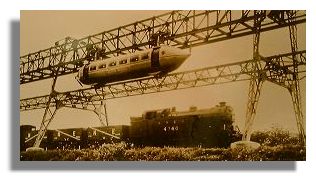
Did You Know?
- Bennie Railplane

Ahead of His Time
George Bennie was born in 1892 and, in the days of steam railway engines, like many small boys he developed a passion for trains. His father was an engineer but young George moved on from taking engines to pieces to designing better ones. It was in 1920, while looking at an early diesel engine, that he had the idea of not only doing away with coal to drive the vehicle but creating a track suspended above the ground with a railcar travelling at 120mph driven by a propeller, which would travel cheaply and speedily from city to city. The "George Bennie Railplane System of Transport" aimed to separate fast passenger traffic from the slower freight trains running on conventional tracks.His brochure advertising the project, described a sleek passenger car with propellers at the front and rear, suspended from the rails above. Using stainless steel and stained glass on the windows, there were carpets and comfortable chairs inside. There was electric lighting and the windows had curtains. Safety was a major feature and there was a double braking system, which could be automatically applied if there was any obstruction on the gantry ahead. Bennie planned to build tracks on top of existing railway lines and with its bountiful speed and power its tracks could take hills in its stride, without having to consider expensive tunneling. Laying track was estimated to be only 50% of the cost of conventional railway track. Bennie estimated that his system could travel between Glasgow and Edinburgh in only 20 minutes at 150mph - in 2004, the present train service takes 50 minutes.
From the outset, his ideas caught the imagination of the public and he won a gold medal at the Industrial Exhibition in Edinburgh in 1922 for his innovative design. Fired with enthusiasm and convinced that he was going to revolutionise transport, Bennie worked hard to transform his ideas into reality.
A Practical Demonstration
To encourage financial backing for his plans, Bennie decided to build a test track but it took until 8 July 1930 before a test track supported by steel girders, 426 feet long, 30 feet above the ground and with a small station from which passengers entered the cigar-shaped carriage. The diesel electric motors propelled the vehicle to the end of the track and back again.Bennie travelled the world seeking financial backing for his revolutionary new form of transport. But at a time when the world was recovering from the Great Depression and another world war was looming, he failed to literally get his concept off the ground.
A Rusty Hulk
The demonstration track for the Bennie Railplane remained in place for over 25 years, a constant reminder of the dangers of being too advanced for the age. George Bennie later ran an herbalist shop and died a bankrupt in 1957, a year after his test track had been dismantled and sold for scrap. Monorails now operate in a number of countries though the one which probably carries the most passengers is the one called "Imagination" which carries visitors between the Magic Kingdom and the Epcott Centre at Disney World in Florida.
Where else would you like to go in Scotland?

